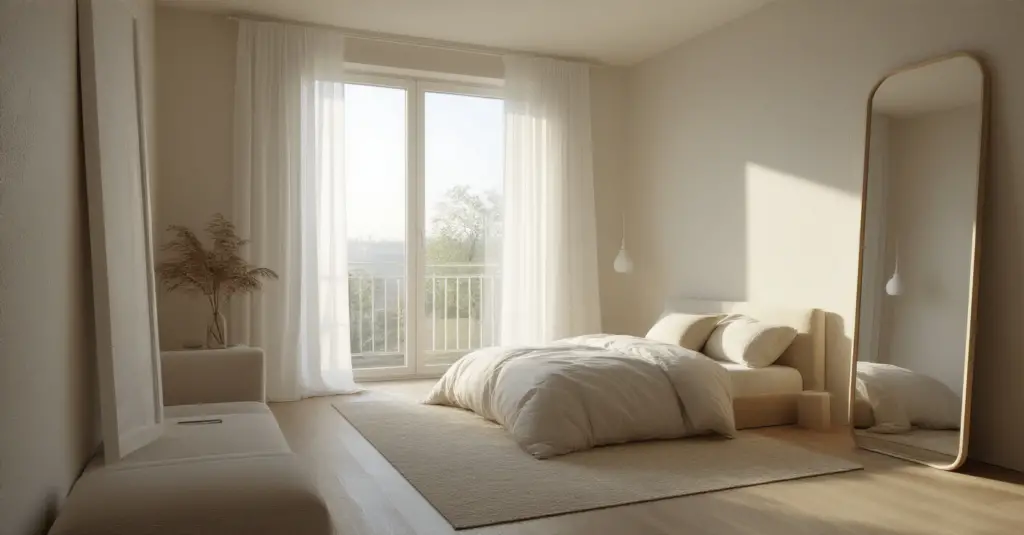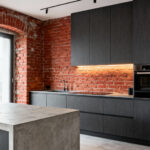Can we talk for a minute about why everyone gets small bedrooms wrong? You see these articles and TV shows about “hacking” your space with endless plastic bins and furniture that contorts like a Transformer. They’re so focused on the visual trick of making a room look bigger that they forget the whole point.
Your bedroom isn’t a storage unit you happen to sleep in. It’s a sanctuary. It’s the first environment your senses take in when you wake up and the last one you experience before you drift off to sleep. And when a space is small, every single sensory input is amplified. The hum of the air conditioner, the feel of the rug underfoot, the scent that lingers in the air—it all matters more.
The real secret to designing a small bedroom isn’t just about clever storage or visual tricks. It’s about designing for your nervous system. It’s about creating a space that feels expansive, nourishing, and deeply restful on a biological level. I learned this years ago when I was just starting out, working with a client in a tiny studio. We filled it with all the “right” small-space furniture, but he still felt tense and boxed in. It wasn’t until we changed the lighting to mimic a sunset, brought in linen sheets that breathed with his skin, and added a simple diffuser with calming sandalwood that his shoulders finally dropped. He didn’t need more space; he needed sensory peace.
So let’s forget the noise about cramming and stacking for a moment. I’m going to share how you can turn your apartment bedroom into a place that truly holds and restores you, using all of your senses.
Smart Planning & Spatial Assessment
Before we bring anything into the room, we have to start by listening to it. Think of this phase as a conversation with your space. You’re learning its rhythms, its quirks, and its quiet strengths. This isn’t about rigid rules; it’s about attuning yourself to the energy of the room so you can work with it, not against it.
1. Evaluate Natural Light Sources for Optimal Placement
The very first texture in any room is light. Notice how I said texture. The cool, blue-white light of early morning feels completely different on your skin than the warm, golden light of late afternoon. This isn’t just poetry; it’s biology. Your body’s internal clock, your circadian rhythm, is tuned by the quality of light you receive. So many design guides talk about light just to make a room look bigger, but we’re going to think of it as the primary nutrient for your well-being.
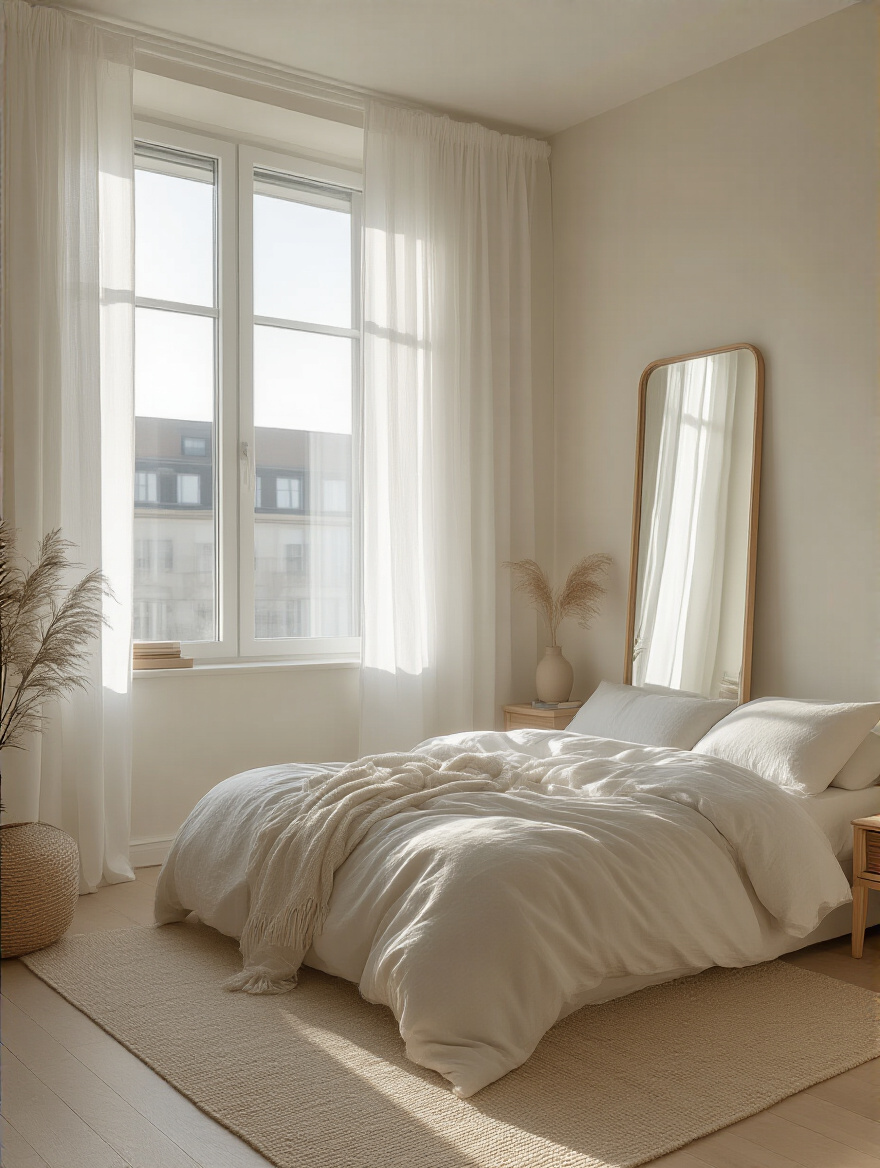
Before you decide where anything goes, spend a day simply observing. Where does the morning light land? That’s a beautiful spot for a small plant or a chair for your morning meditation, a place to greet the day. Where does the harsh afternoon sun hit? That’s where you might want softer, diffused curtains, not your desk. By placing your bed where it’s protected from direct morning glare, you allow your body to wake up gently, which sets a calm tone for your entire day.
Understanding the room’s natural light isn’t a technical step; it’s an act of respect for the natural energies that flow through your home.
2. Precise Room Measurement: Map Out Every Inch for Efficiency
I know, pulling out a tape measure can feel so clinical. But I want you to reframe this. This isn’t about creating a rigid blueprint; it’s about understanding the container you’re working with so you can create a feeling of effortless grace. Friction—physical and mental—is the enemy of a restful space. Bumping into the corner of a dresser every morning or squeezing past the end of your bed creates tiny, cumulative moments of stress that your body holds onto.
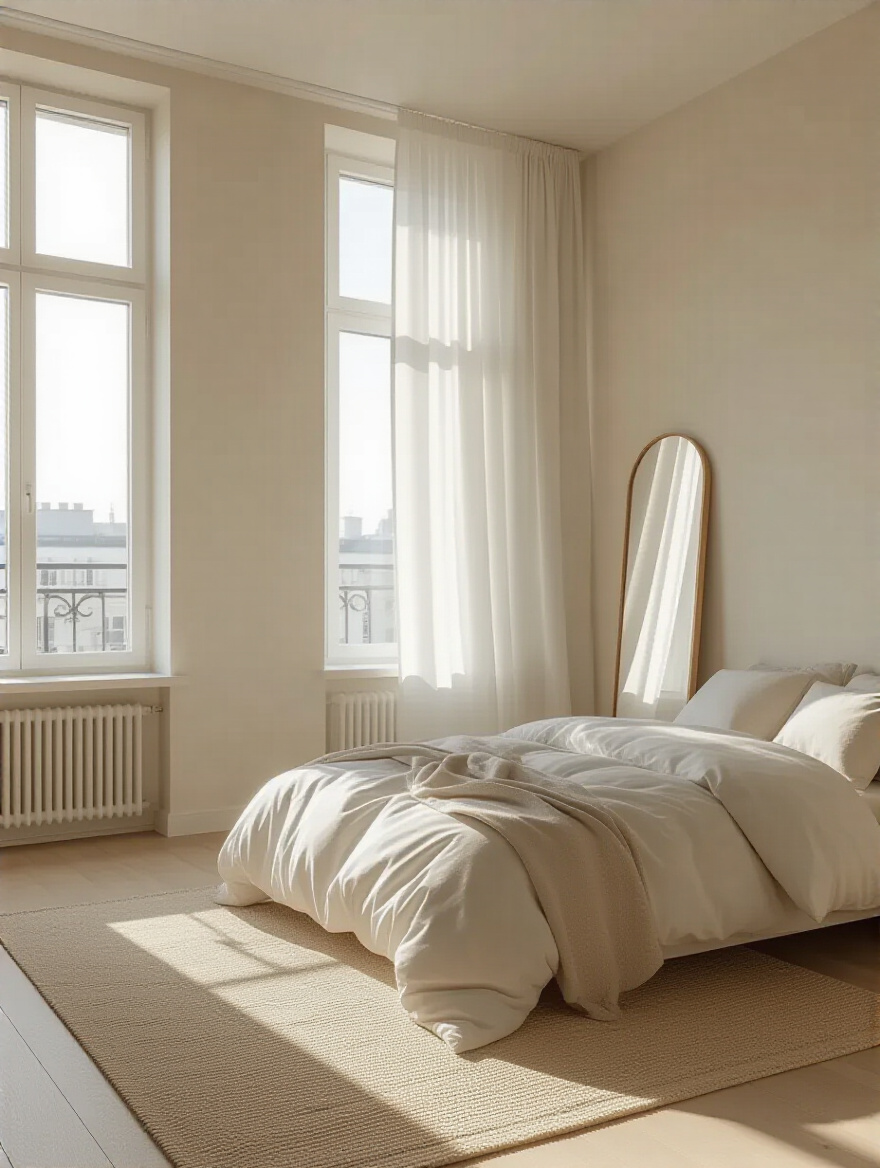
I once had a client who bought a bed frame that was just three inches too long for his room. Three inches! It wasn’t a disaster, but it meant his path to the closet was always a little pinched. He didn’t even consciously notice it, but he confessed the room just felt “annoying.” By measuring precisely, you are choreographing a dance of ease. You are ensuring that your movements through your most personal space can be fluid and unobstructed, which sends a powerful signal of calm to your nervous system.
This isn’t about math. It’s about designing for a body that needs to move with ease. Think of it as creating clear rivers for energy to flow.
3. Define Your Personal Style and Desired Ambiance
Let’s throw out the labels like “mid-century modern” or “bohemian” for a second. When you close your eyes and imagine your most restful state, what do you feel? Are you walking barefoot on a cool, smooth stone floor? That’s a minimalist sensory profile. Or are you wrapped in a soft, chunky knit blanket, surrounded by warm wood and the scent of old books? That’s a more layered, cozy profile. Your personal style is simply your unique sensory recipe for calm.
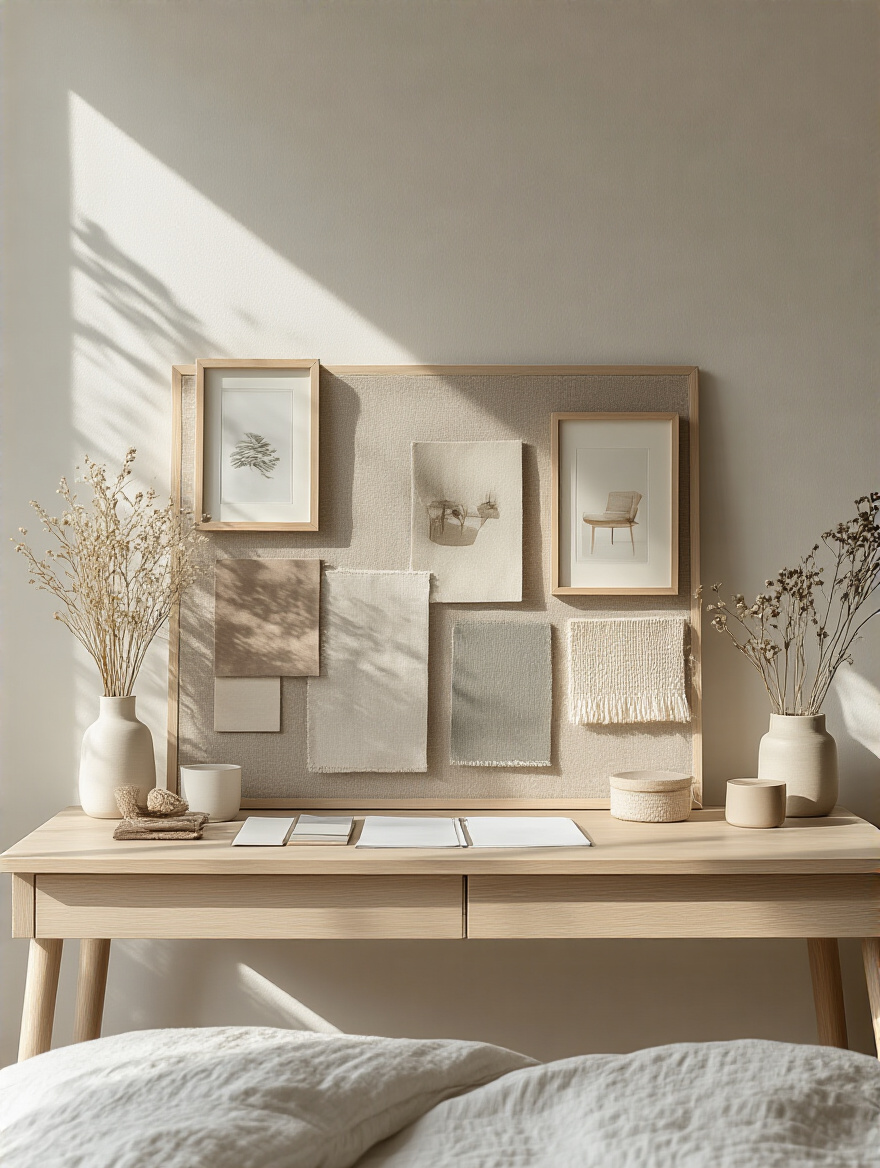
Create a mood board, but don’t just pin images. Write down textures, scents, sounds, and feelings. “The cool smoothness of silk.” “The scent of petrichor after it rains.” “The warm glow of candlelight.” These are your true design guides. This process connects your aesthetic choices to a deeper emotional and physiological need, ensuring your bedroom won’t just look good, but will actively soothe you on a primal level.
Once you know the feeling you’re aiming for, every decision becomes simple. You just ask: “Does this object contribute to that feeling?”
4. Prioritize Functional Zones: Sleep, Storage, and Relaxing
Instead of “zones,” let’s call these “rituals.” A small bedroom has to support several rituals: the ritual of rest, the ritual of dressing, the ritual of winding down. By dedicating a small, specific space to each of these, you give your mind cues that help it transition. You’re not just carving up a room; you’re honoring the different parts of your day and your life.
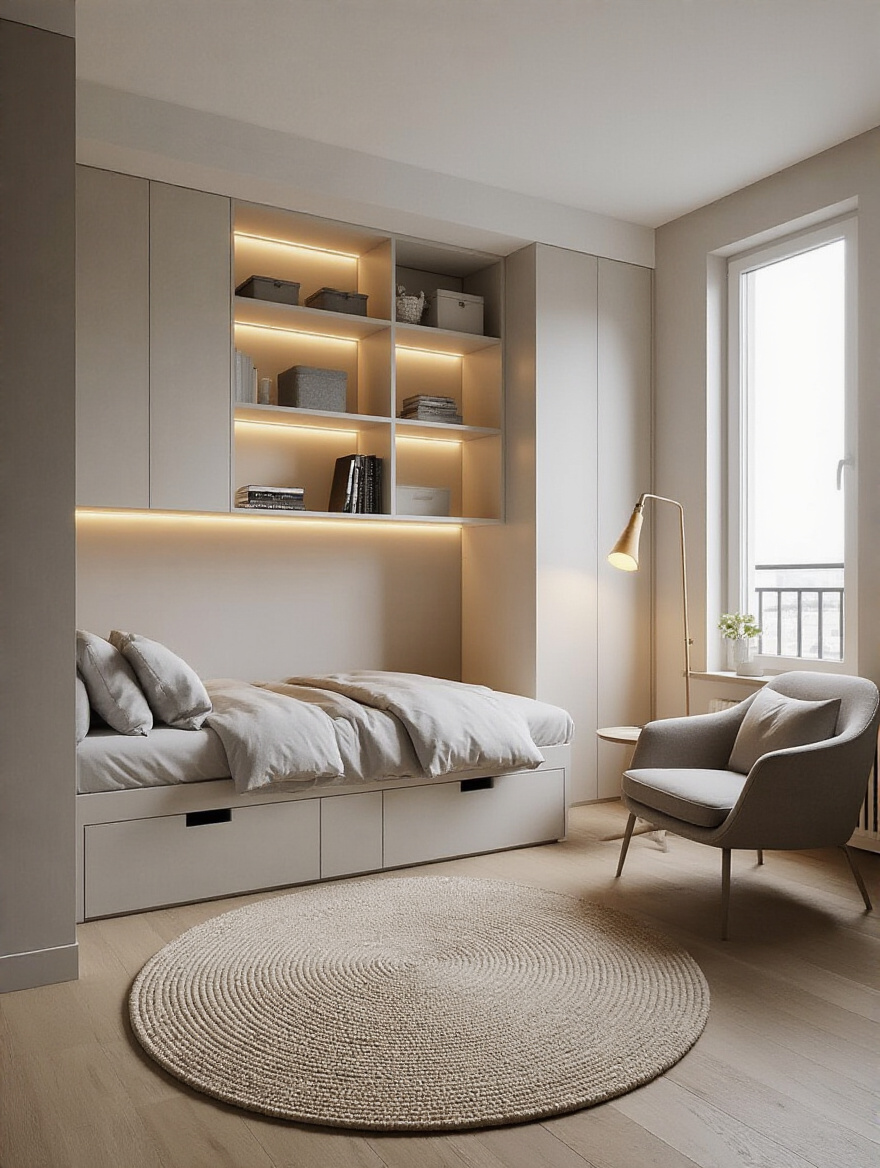
Your sleep ritual space is sacred. This area—your bed, your nightstand—should be pristine, reserved only for rest and intimacy. Your dressing ritual might be centered around your closet and a full-length mirror, a clean corner where you can greet your body each day. And your winding-down ritual could be a single comfortable chair with a soft lamp and a tiny table for a cup of tea. Even if this “chair” is just a stack of floor pillows, intentionally separating the energy of these activities is transformative in a small space.
This practice tells your brain, “This is where we rest,” creating a powerful psychological boundary that helps you sleep deeper and feel more present in your own home.
5. Draft Floor Plans to Visualize Furniture Layouts
Again, this sounds technical, but I want you to see it as a form of daydreaming on paper. Before you exhaust yourself by physically moving a heavy bed, you can explore possibilities with zero effort. Think of this as the choreography for your room’s energy. Does placing the bed here allow morning light to wake you gently? Does this layout create a clear, calming path from the door to the window?
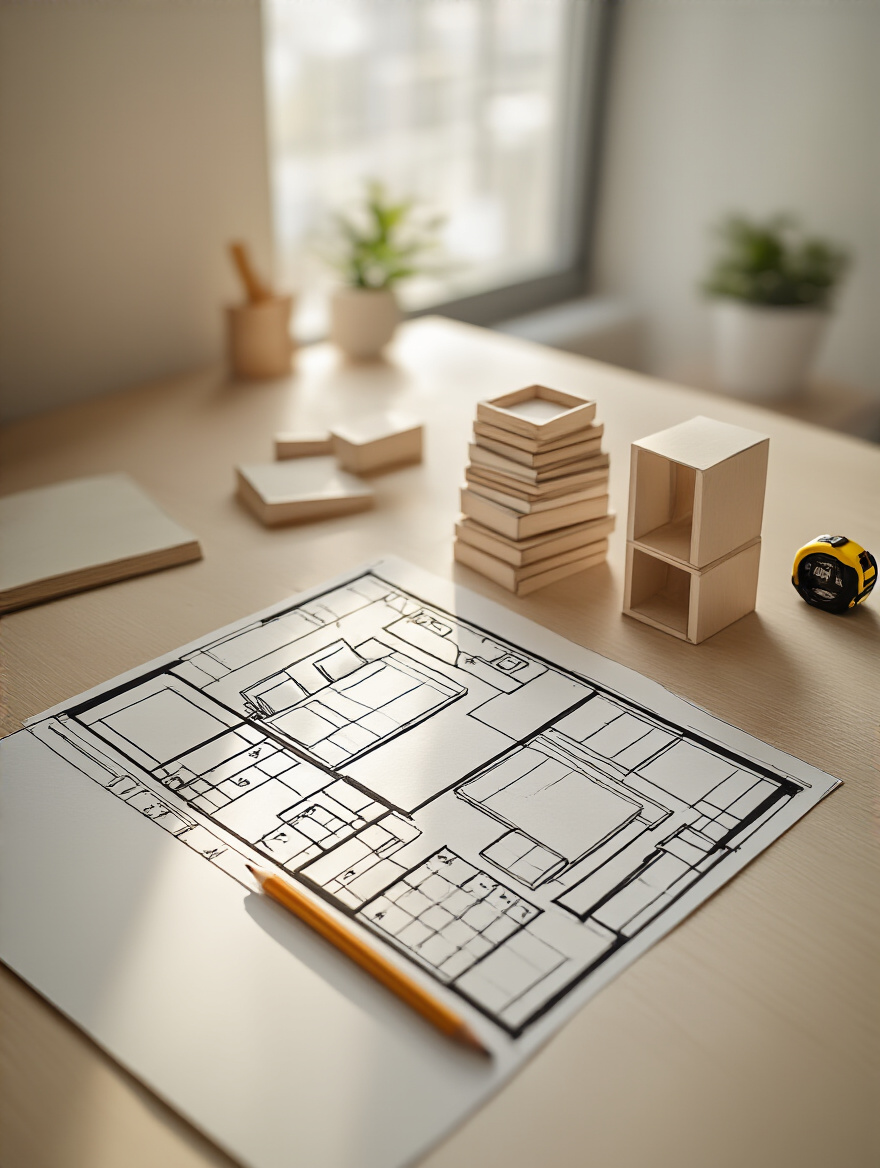
Use painter’s tape on the floor to outline where furniture will go. This is a shortcut I swear by. It allows you to feel the space before you commit. Walk through the taped-out room. How does it feel to get out of bed? To open your closet? Your body knows. It will tell you if a layout feels cramped or if it feels open and liberating.
This simple act of pre-planning prevents the low-grade stress of a poorly arranged room and allows you to find that one perfect layout that feels like a deep, welcome exhale.
Clever Furniture & Layout Strategies
The objects we live with have their own energy. In a small space, this is even more true. Furniture shouldn’t be a passive occupant of your room; it should be an active partner in creating a sense of peace and possibility. It’s about choosing pieces that work hard but feel light.
6. Invest in multi-functional furniture for Dual Purpose
Everyone says multi-functional furniture is about “saving space.” And it is. But more importantly, it’s about reducing the number of objects in your field of vision, which gives your mind less information to process. Think of a cluttered room as visual noise. Your brain has to work, even subconsciously, to filter it all out. When a single piece of furniture can be your storage, your seat, and your ottoman, you’ve quieted that noise.
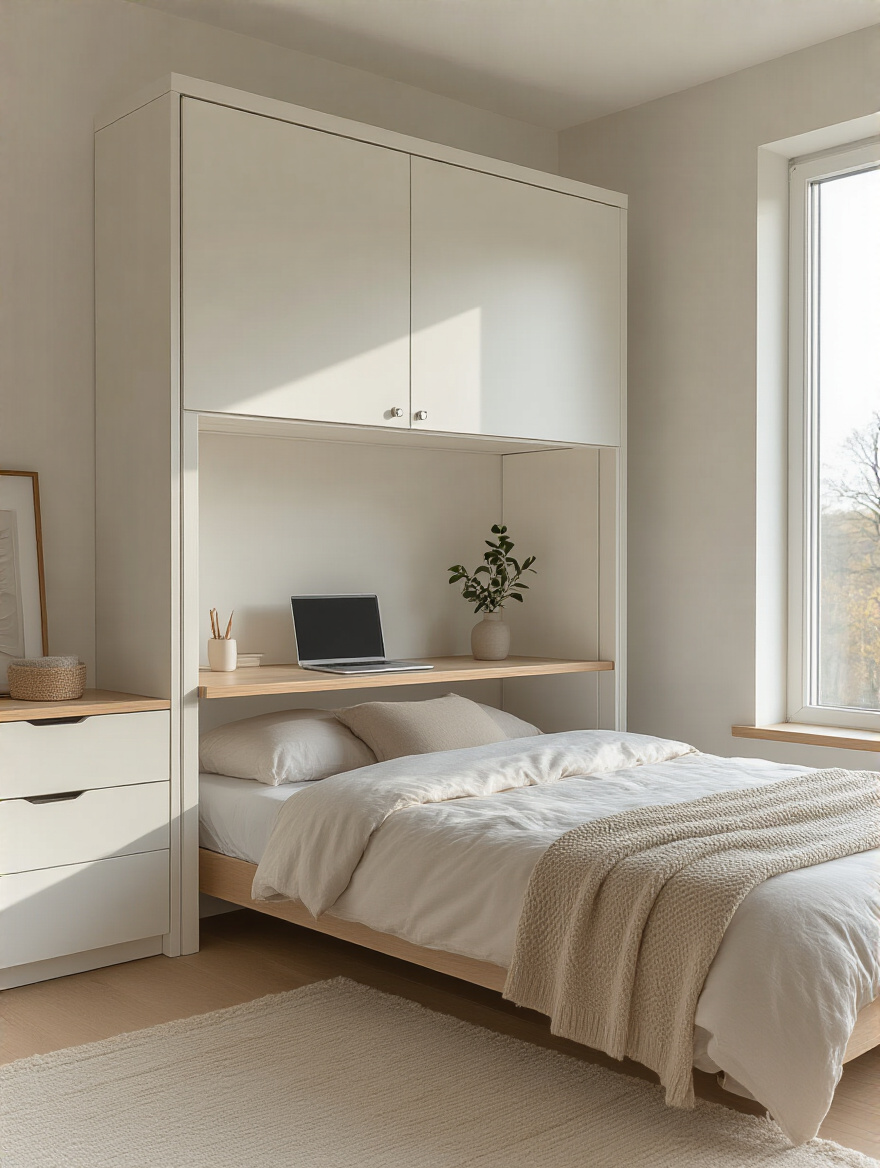
An ottoman with hidden storage is wonderful, but it’s not just for blankets. It’s a place to tuck away the day’s anxieties. A Murphy bed that folds up to reveal a desk isn’t just a clever gimmick; it’s a powerful ritual tool for transitioning your mind from work mode to rest mode. This act of physically transforming your space helps you mentally close the door on your workday and open the door to deep relaxation.
This isn’t about hiding your stuff; it’s about creating a visual and energetic spaciousness that allows your mind to rest.
7. Select a Bed Frame That Suits Room Scale, Not Just Your Comfort
Your bed is the heart of your sanctuary. But an oversized, heavy bed frame in a small room can feel like an anchor, energetically weighing the entire space down. A massive headboard can feel like it’s looming over you, subtly compromising your sense of safety while you sleep. We want a bed that feels grounded and supportive, but also light.
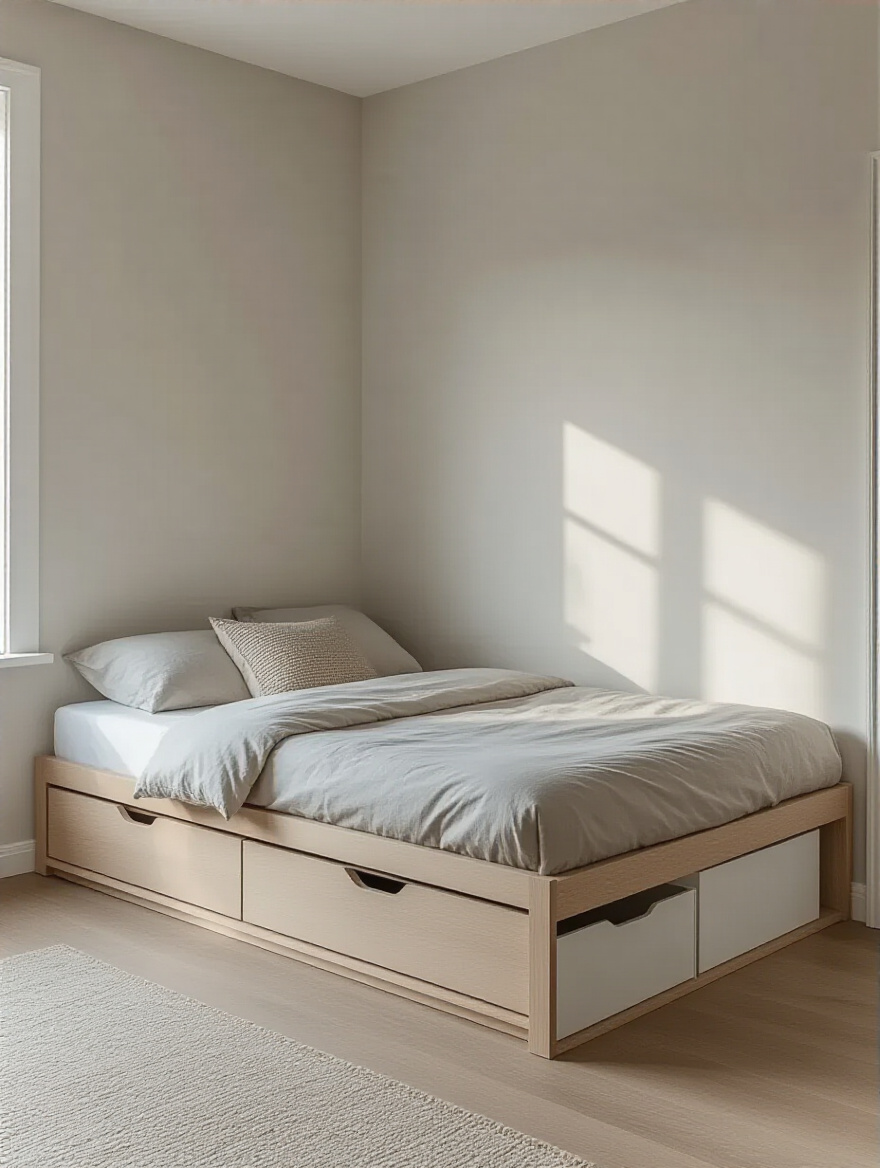
Choose frames that have visual “air” to them. Low-profile platform beds let you see more of the floor, which creates an illusion of space. Frames with simple legs instead of a solid base allow light and energy to flow underneath. You’re looking for a piece that can hold you securely without visually consuming the room. I often recommend my clients just a simple frame with a separate, wall-mounted headboard made of a soft, upholstered material to save those crucial few inches of depth.
Remember, the space around your bed is breathing room. For you, and for your spirit. Protect it.
8. Utilize Vertical Space with Tall Bookshelves or Wall-Mounted Units
There’s a reason we stretch our arms up to the sky when we wake up. Drawing energy upward is an instinctively uplifting act. When you use vertical space in your bedroom, you’re not just creating storage; you’re creating that same sense of lift and expansion for your eyes and your spirit. A tall, narrow bookshelf draws the eye upward, making the ceiling feel higher and the room feel grander.
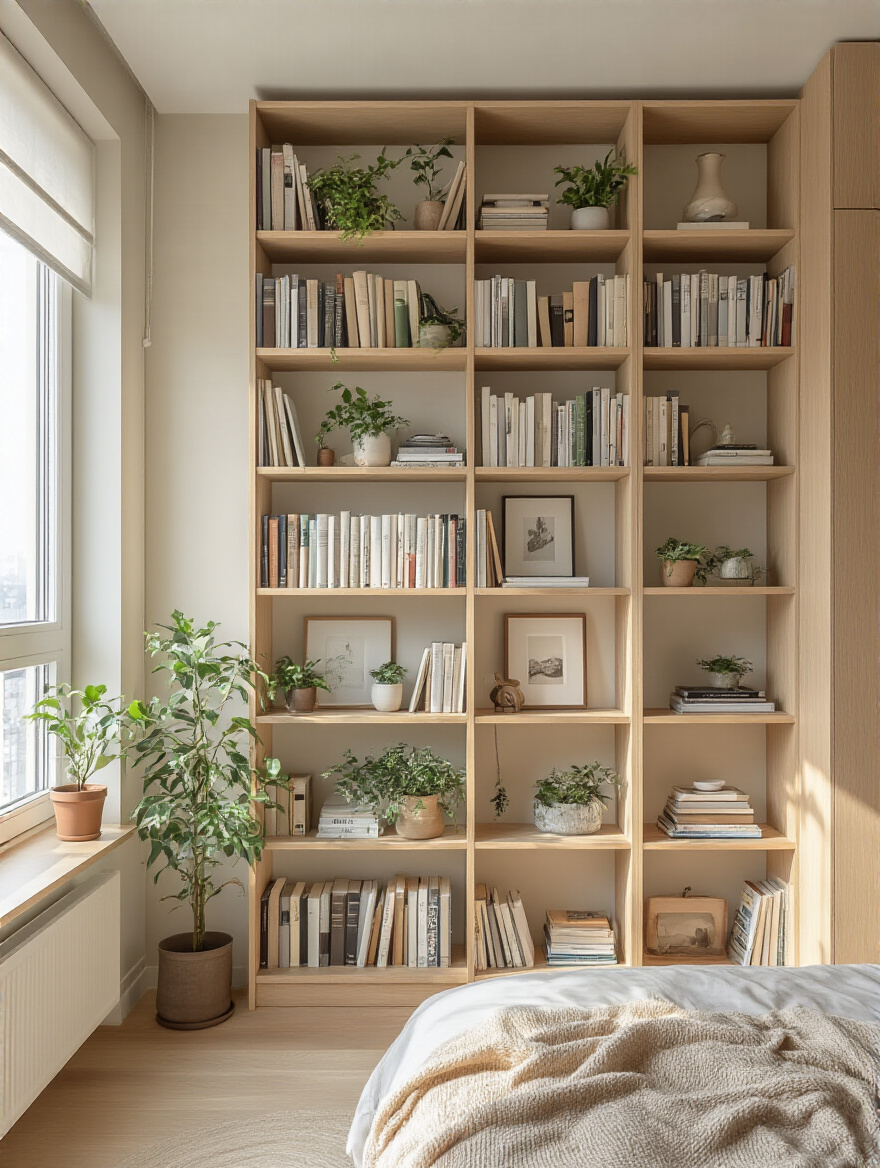
Wall-mounted shelves are my favorite tool for this. They float. They have a weightlessness that keeps a small room feeling airy and uncluttered. Use them to display objects that bring you joy—not just books, but beautiful stones, a trailing plant, a piece of art. This turns your storage into a vertical gallery of things that nourish your soul, lifting your gaze and your mood every time you walk into the room.
And please, put a plant on a high shelf. Watching life cascade downward brings a beautiful, gentle energy into a space.
9. Optimize Closet Space with Smart Organizers and Custom Solutions
Think about the first thing you do every morning. For many of us, it’s opening the closet. That first interaction sets the tone for your day. If you open the door to a cascade of clutter, a tangle of hangers, and a feeling of chaos, you are starting your day with a jolt of stress. It’s a micro-moment, but it matters. An organized closet is an act of kindness to your future self.
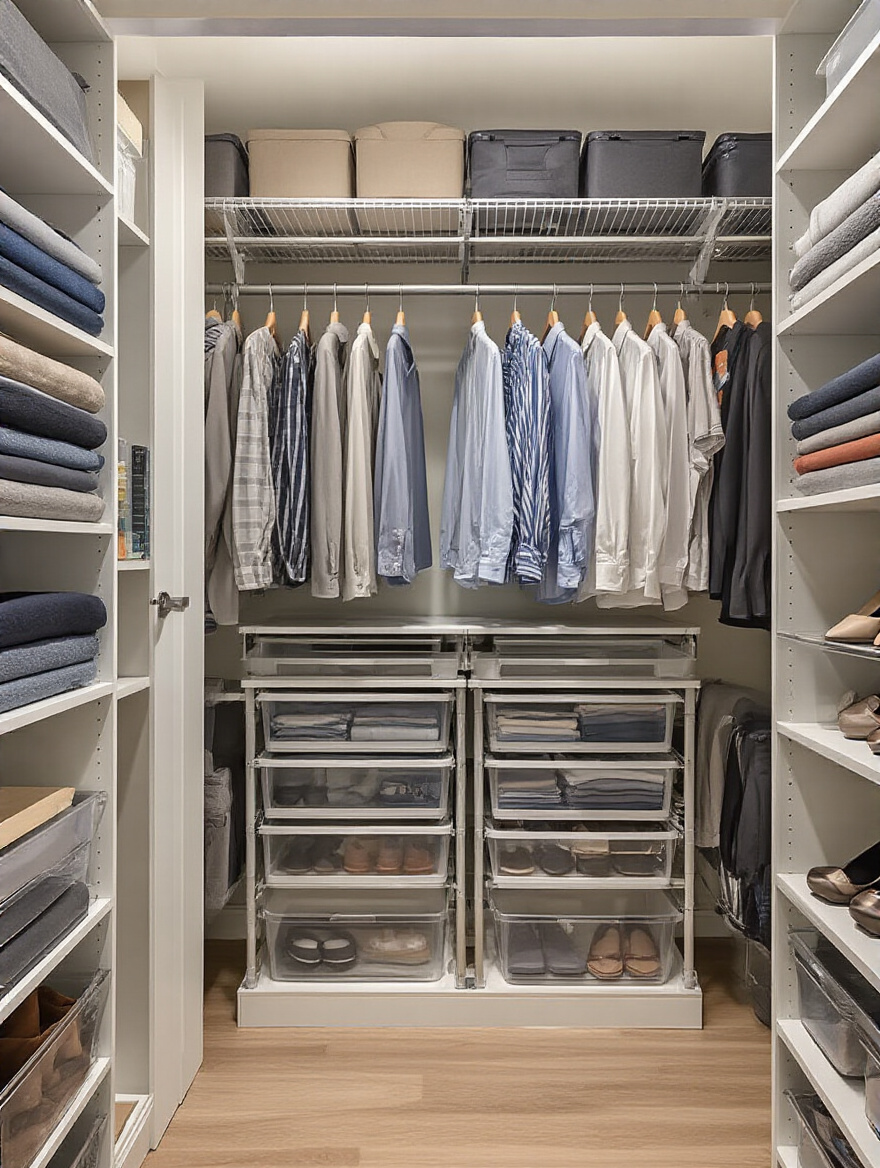
A clear, organized closet isn’t about perfection; it’s about ease. It’s about being able to reach for what you need without a frustrating search. Use slim velvet hangers—they not only save space but provide a soft, uniform texture that is calming to the eye. And here’s my little aromatherapy secret: tuck sachets of dried lavender or cedar blocks into your drawers and on your shelves. It transforms the act of opening your closet from a chore into a moment of subtle, beautiful sensory pleasure.
A calm closet leads to a calm morning, which leads to a calmer you.
10. Choose Space-Saving Nightstand Alternatives
The area right beside your bed should be a sacred space. It’s the last surface you touch at night and the first you reach for in the morning. A big, clunky nightstand loaded with clutter creates stagnant energy right where you rest your head. We want to clear this space, keeping only the most essential, beautiful, and calming objects nearby.
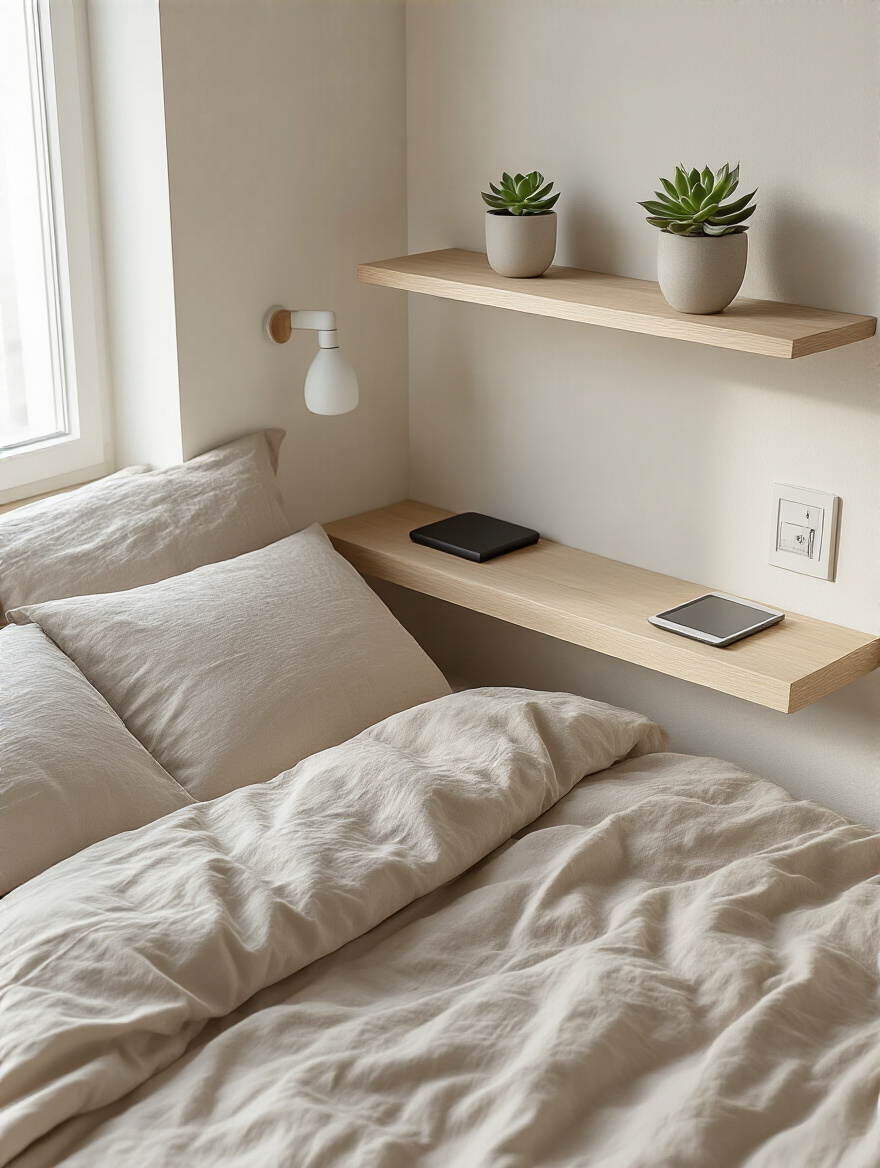
A simple floating shelf mounted to the wall is often all you need. It provides a weightless surface for a book, a small glass of water, and perhaps a tiny vase with a single flower. It keeps the floor clear, which makes the room feel more open, and it forces you to be intentional about what you keep beside you. C-tables that can slide over your mattress are also wonderful because they are there when you need them and disappear when you don’t.
This choice is about curating a serene bubble of calm right around your pillow, protecting your energetic space while you sleep.
11. Ensure Clear Pathways to Maintain Open Flow
In the practice of Feng Shui, clear pathways are essential for allowing “chi,” or life-force energy, to move freely through a space. You don’t have to be a master to understand this intuitively. When your path is blocked, you feel stuck. When you have to squeeze and turn to get from your bed to the door, your body tenses up. That physical constriction creates mental constriction.
Clear, open pathways are non-negotiable for a peaceful bedroom. They allow you to move with an unconscious grace and ease. Aim for at least 24 to 30 inches of walking space around your bed and on the main route to the door. This isn’t just practical; it’s symbolic. It creates a feeling of possibility and freedom, even in the smallest of rooms.
Let your movements be a dance, not an obstacle course. This single principle can change the entire feeling of a room more than any piece of furniture.
Ambiance, Texture & Personal Touch
This is where the soul of the room comes alive. We’ve built the foundation—the container—and now we get to fill it with the textures, light, and scents that will make it a true, multi-sensory sanctuary. This is where your unique energy transforms a simple room into a personal haven.
12. Master Layered Lighting for Versatile Moods
Light is your most powerful tool for shaping the emotional landscape of your room. A single, harsh overhead light is the enemy of serenity. It flattens everything and tells your brain it’s the middle of the day, which is not what you want before sleep. Mastering layered lighting is about giving yourself the power to dial in the perfect sensory environment for any moment. You need three layers.
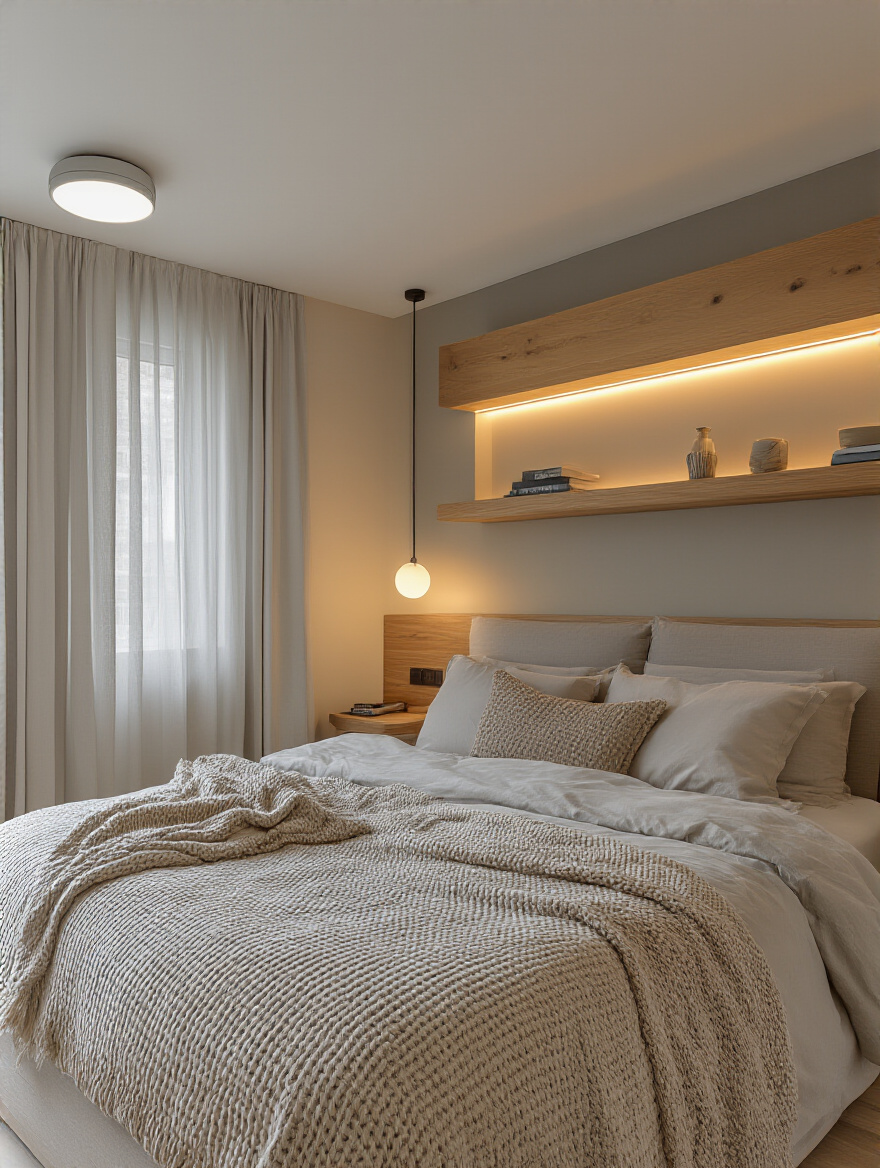
First, your ambient layer: a soft, central ceiling light on a dimmer. A dimmer is not a luxury; it is a necessity for a restful bedroom. Second, your task layer: a gentle, focused light for reading, like a wall-mounted sconce with a warm-toned bulb. This allows you to read without illuminating the whole room. Finally, the magic layer: your accent light. This is the warm, primal glow of a Himalayan salt lamp, the gentle flicker of a beeswax candle (used safely, of course), or a strand of fairy lights. This low, warm light signals to your pineal gland that it’s time to produce melatonin, helping you fall asleep naturally.
This isn’t just decorating. This is actively working with your biology to curate a state of deep and profound rest. It’s the final, and most important, secret to transforming your apartment bedroom into a sanctuary.
Conclusion
Creating a soulful apartment bedroom has so little to do with the size of the room and everything to do with the intention you bring to it. It’s about understanding that you are designing a space for a living, breathing body with a sensitive nervous system that craves peace. Your home, and especially your bedroom, should be the one place in the world that is tuned specifically to you.
You don’t need a bigger space; you need a more intentional one. By listening to the room, choosing pieces that feel light and supportive, and layering in the sensory details that bring you calm—the gentle light, the soft textures, the beautiful scents—you create a haven. You create a room that doesn’t just hold your body, but holds your spirit, too. Let your bedroom be a testament to the fact that peace isn’t found in square footage, but in the tender, thoughtful care we give to ourselves and our surroundings. Go create your oasis.
